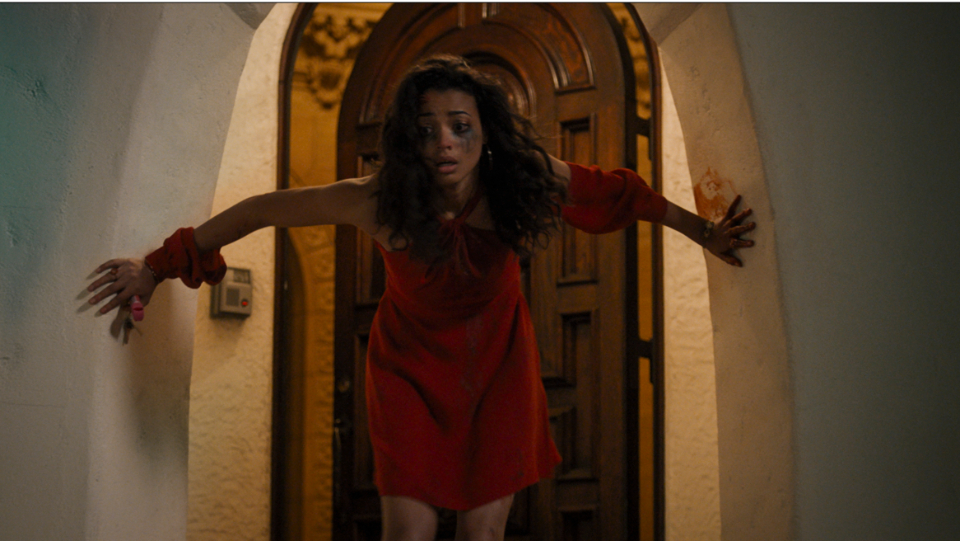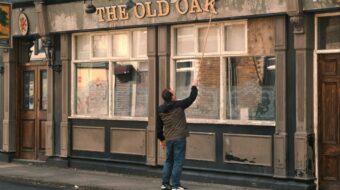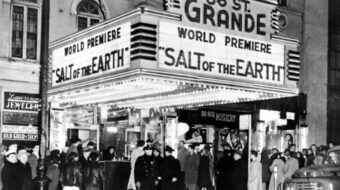
When the hashtag #MeToo went viral online in connection to countless women stepping forward with their stories of sexual harassment and assault, it felt as though a social reckoning was upon us. It was an emboldening time, with society seemingly ready to reflect and hold accountable not only abusive men in power, but the system that enables such corruption and danger for women. Yet, as one too many of the infamous perpetrators simply waited out their ostracization to emerge again unscathed, many were left wondering whether anything had really changed. The new film Run Sweetheart Run bottles up all that frustration and anger at a system embedded with sexism and hurls it at the screen in all its (literal) bloody glory.
The supernatural horror film mixes in elements of suspense, action, and biting social commentary to deliver a whirlwind adventure. This isn’t a quiet, somber film about the subjugation of women; it is a loud in-your-face condemnation of it. It is the therapeutic #MeToo horror film the world needs. Some may feel like many of the themes are too “on the nose,” but the film is unapologetic in its messaging. It wants you to understand exactly what it’s saying without any vagueness. Yet, there is a masterful balance in the vibrant cinematic world, where it never feels like it loses its way in creating a compelling story throughout.
Directed by Shana Feste, who co-wrote the screenplay with Keith Josef Adkins and Kellee Terrell, Run Sweetheart Run tells the story of a young legal secretary named Cherie (Ella Balinska) who, as a favor, goes on a business dinner with her boss’s wealthy client James (Pilou Asbæk). What starts out as a pleasant—perhaps even romantic—evening soon turns deadly, as Cherie finds herself in a fight for her life. The young single mother is attempting to survive the night as she is hunted down through the city by an otherworldly predator that has many links to the non-supernatural dangers women often face in society.
This movie has style, and brings a vibrance to what could have been a dreary Los Angeles nightscape. The audience is taken on a colorful journey as Cherie travels through various places looking for some sort of security and help. Although there’s an overarching plot of Cherie trying to outrun danger, there are also smaller moments where she finds herself in places that can be seen as reflective of areas where women have been known to run into issues. These include interactions with law enforcement, gas stations, and nightclubs. This shows the audience that Cherie’s story is not just her own; it’s woven into a wider tapestry of women attempting to survive in a society where danger lies in even the most inconspicuous places.
Run Sweetheart Run also does a great job of subverting often overused horror tropes involving women. One in particular deals with the way the female body is displayed and dealt with on screen. Far too often when it comes to movies, women are displayed in an objectified way, even if they are the heroine of the film. Bare breasts and inconvenient clothing can run rampant in these types of movies with little to no explanation. That is not the case here.
Cherie’s body is very much a topic of conversation— but it is not to be sexualized. This is perhaps one of the few movies I have seen where a woman being on her period (menstruation that involves vaginal bleeding) is not only shown and discussed in a natural way, but also is involved in key aspects of the plot. For far too many decades, a woman’s period—just like her orgasm—was seen as a taboo topic to be left in the shadows. It was something to be thought of as dirty and shameful instead of a natural process for many women. Run Sweetheart Run says to hell with that.
This choice to boldly include a natural function of many females’ anatomy may make some uncomfortable. Then again, perhaps it would help for some to reflect on why being subjected to this kind of (natural) blood makes them uncomfortable but cinematic blood as the result of brutal violence does not.
There will be those who will complain about seeing bloody tampons on screen, yet turn around and praise a scene involving a bare-chested woman being cut in half by a sadistic (male) killer in some run-of-the-mill horror installment. It’s clear that Run Sweetheart Run is aiming to challenge those people on why exactly they have that kind of response.
By the third act, some may feel like the film abandons the horror and turns more towards action. One could argue that this comes in response to the intense fear that built up through the first two-thirds of the movie. Horror can sometimes take on a nihilistic tone, leaving the sense there is no hope. Run Sweetheart Run pushes back against that perspective and—in taking on a more proactive stance—revs up the action. This feels like a natural progression towards an explosive and wholly satisfying climax.
Added layers of race and class are thrown into the mix with the choice of having our main protagonist, played by the formidable Ella Balinska, be a young Black working woman. This too influences a number of her interactions in an impactful way.
If you’re wary of seeing gratuitous violence towards women in film in order to “drive home the point,” then there’s no need to worry about that here. Run Sweetheart Run has a clever way—which I won’t spoil—of avoiding a pitfall that many movies handling this subject matter unfortunately fall into.
The movie is hip and timely. It gives good scares, action, and a story that doesn’t overstay its welcome. Director Freske uses the genre of horror, like many iconic filmmakers have in the past, to highlight societal ills that need some re-examining. If you like sharp social commentary interwoven within your horror, then you should definitely give Run Sweetheart Run a watch.
Run Sweetheart Run is currently streaming on Prime Video.












Comments